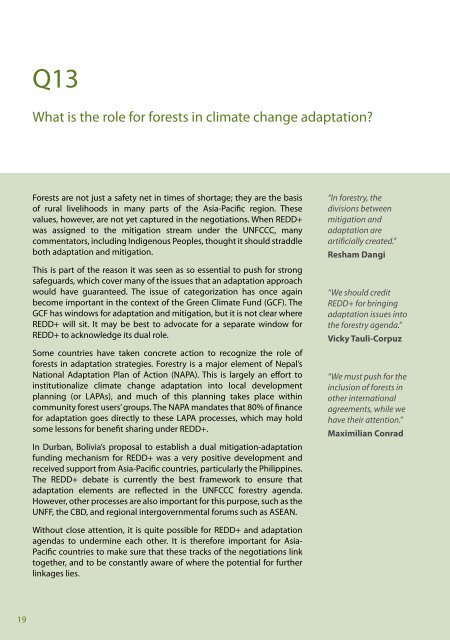Forests and climate change after Durban - RECOFTC
Forests and climate change after Durban - RECOFTC
Forests and climate change after Durban - RECOFTC
You also want an ePaper? Increase the reach of your titles
YUMPU automatically turns print PDFs into web optimized ePapers that Google loves.
Q13What is the role for forests in <strong>climate</strong> <strong>change</strong> adaptation?<strong>Forests</strong> are not just a safety net in times of shortage; they are the basisof rural livelihoods in many parts of the Asia-Pacific region. Thesevalues, however, are not yet captured in the negotiations. When REDD+was assigned to the mitigation stream under the UNFCCC, manycommentators, including Indigenous Peoples, thought it should straddleboth adaptation <strong>and</strong> mitigation.This is part of the reason it was seen as so essential to push for strongsafeguards, which cover many of the issues that an adaptation approachwould have guaranteed. The issue of categorization has once againbecome important in the context of the Green Climate Fund (GCF). TheGCF has windows for adaptation <strong>and</strong> mitigation, but it is not clear whereREDD+ will sit. It may be best to advocate for a separate window forREDD+ to acknowledge its dual role.Some countries have taken concrete action to recognize the role offorests in adaptation strategies. Forestry is a major element of Nepal’sNational Adaptation Plan of Action (NAPA). This is largely an effort toinstitutionalize <strong>climate</strong> <strong>change</strong> adaptation into local developmentplanning (or LAPAs), <strong>and</strong> much of this planning takes place withincommunity forest users’ groups. The NAPA m<strong>and</strong>ates that 80% of financefor adaptation goes directly to these LAPA processes, which may holdsome lessons for benefit sharing under REDD+.In <strong>Durban</strong>, Bolivia’s proposal to establish a dual mitigation-adaptationfunding mechanism for REDD+ was a very positive development <strong>and</strong>received support from Asia-Pacific countries, particularly the Philippines.The REDD+ debate is currently the best framework to ensure thatadaptation elements are reflected in the UNFCCC forestry agenda.However, other processes are also important for this purpose, such as theUNFF, the CBD, <strong>and</strong> regional intergovernmental forums such as ASEAN.“In forestry, thedivisions betweenmitigation <strong>and</strong>adaptation areartificially created.”Resham Dangi“We should creditREDD+ for bringingadaptation issues intothe forestry agenda.”Vicky Tauli-Corpuz“We must push for theinclusion of forests inother internationalagreements, while wehave their attention.”Maximilian ConradWithout close attention, it is quite possible for REDD+ <strong>and</strong> adaptationagendas to undermine each other. It is therefore important for Asia-Pacific countries to make sure that these tracks of the negotiations linktogether, <strong>and</strong> to be constantly aware of where the potential for furtherlinkages lies.19
















